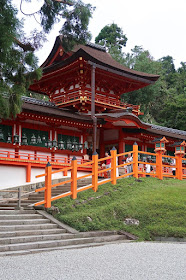Kasuga-Taisha Shrine is the most important Shinto shrine in Nara, a mysterious world of forest, pathways, lanterns and wandering deer nestled deep in Nara's lush primeval Kasugayama Forest, both UNESCO World Heritage sites of ancient Nara. Originally the royal shrine of the Fujiwara family, Japan’s most powerful family clan during most of the Nara and Heian periods, Kasuga-Taisha is known for the hundreds of brass and bronze lanterns scattered across its interior, and the thousands of extraordinary stone lanterns known as tōrō, that line the path up to the shrine, each one donated over the years by common people as tokens of faith and thankfulness, and used to be lit every night. Now they are only lit a few days each year during the Man-tōrō festivals of early February and mid-August. Shinto, meaning 'way of the gods,' is the oldest religion in Japan, and is based upon the worship of kami, or spirits, such as the wind or thunder, or objects of nature such as mountains, rivers and trees, which is why Shinto shrines are frequently located in hillside forests or natural landscapes. In Nara, Shinto shrines also require a protective spirit, and at Kasuga-Taisha, a thunder god known as Kashima-no-kami was invited to reside at the shrine. According to the shrine’s story, the god came to the shrine riding on a perfect white stag, and for that reason, deer became a sacred symbol of the shrine ever since.
Vermillion Torii or sacred gate at the Kasuga Taisha Shinto shrine with yellow tape
to restrict access due to a fallen tree from Typhoon Jebi
Kasuga-Taisha is most well known for the thousands of stone lanterns known as tōrō
that line the paths to the shrine
One of the ‘divine’ deer herd of Nara
Deer-shaped purification fountain at the entry of Kasuga-Taisha Shrine,
for to the Shinto they are venerated as messengers of the Gods
Moss covered stone tōrō in front of Shinto monks house
Kasha-Taisha Shrine of the Lanterns
Booth outside Minamimon Gate selling good luck deer mementos
Shrine maiden or 'Miko' with elaborate kimono and wisteria flowers in their headdress, symbolic if the shrine's patron the Fujiwara clan, as she sells prayers and mementos to Shinto worshippers
Shinto Priest raking gravel of the Ringo-no-Niwa Zen Garden at Kasuga-Taisha Shrine
Enormous 1000-year old cypress tree called Honsha-Osugi pierces through the roof of the Naoraiden
The vermillion Middle Gate to the Kasuga-Taisha main hall
Shinto worshipper bowing before the shrine
Lady selling tickets to Fujinaminoya hall as well as Omikuji fortunes and Japanese calligraphy brushes
Brass lanterns outside the Utsushidono in the inner section of the Kasuga Shrine
Fujinaminoya hall in the inner section of Kasuga Shrine with an astounding collection of brass and bronze lanterns which are continuously lit in a pitch black mirrored room
Lantern made with Japanese washi paper to allow the light to come through
One lantern with the iconic Nara deer
The Minamimon is the south gate of Kasuga-Taisha and main entrance to the shrine complex
Beautiful stone tore lanterns nestled in the lush primeval Kasugayama Forest
Some of the stone torii have newer wooden lanterns installed by the owner
Omikuji are fortunes written on strips of paper and tied around the branches of a pine tree
Kasuga Taisha Shrine, part of the World Heritage sites of ancient Nara, has a vested interest in maintaining the deer herds as they have become a symbol of the temple
Small vermillion thatched shrine amid ancient stone torii
The enormous fallen tree that blocked entry through the Torii Gate,
and even crushed some of the stone lanterns
Stone lantern covered with moss and ferns
Chōzuya with spring water in a stone basin with wooden dippers for the symbolic purification rite known as temizu, for worshippers before they approach a Shinto shrine
www.kasugataisha.or.jp/about/index_en






























No comments:
Post a Comment